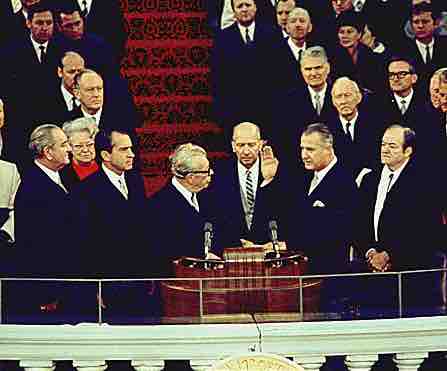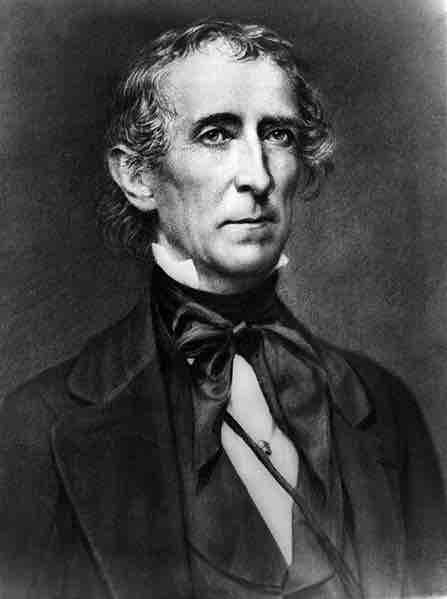Introduction
The Vice President of the United States holds a public office created by the United States Constitution. The vice president, together with the president of the United States, is indirectly elected by the people through the Electoral College to a four-year term of office. The vice president is the first person in the presidential line of succession, and would ascend to the presidency upon the death, resignation, or removal of the president. While the vice president's only constitutionally prescribed functions, aside from presidential succession, relate to his role as President of the Senate, the office is commonly viewed as a component of the executive branch of the federal government. The current vice president is former U.S. Senator Joseph Biden.
Official Portrait of Joe Biden
Official portrait of Vice President of the United States Joe Biden.

Four Vice-Presidents
Four Vice Presidents: L-R, outgoing Pres. Lyndon B. Johnson (the 37th vice president); incoming Pres. Richard Nixon (36th); Everett Dirksen; Spiro Agnew, incoming vice president (39th); and the outgoing Vice President Hubert Humphrey (38th), January 20, 1969.
Under the Constitution, the vice president is President of the United States Senate. In that capacity, he or she is allowed to vote in the Senate, when necessary, to break a tie. While Senate customs have created supermajority rules that have diminished this constitutional power, the vice president still influences legislation. According to the Twelfth Amendment, the vice president presides over the joint session of Congress when it convenes to count the vote of the Electoral College.
Origin
The creation of the Office of Vice President was a direct consequence of the Electoral College. Delegates to the Philadelphia Convention gave each state a number of presidential electors equal to that state's combined share of House and Senate seats. Yet, the delegates were worried that each elector would only favor his own state's favorite son candidate, resulting in deadlocked elections that would produce no winners. To counter this presumed difficulty, the delegates gave each presidential elector two votes, required that at least one of those votes be for a candidate from outside the elector's state, and mandated that the winner of the election obtain an absolute majority with respect to the total number of electors.
With these rules in place, the delegates hoped each electors' second vote would go to a statesman of national character However, fearing electors might throw away their second vote to bolster their favorite son's chance of winning, the Philadelphia delegates specified that the runner up in the election would become vice president. Creating this new office imposed a political cost on discarded votes and, thus, required that electors cast their second ballots.
Roles of the Vice-President
As President of the Senate, the vice president has two primary duties: to cast a vote in the event of a Senate deadlock and to preside over and certify the official vote count of the U.S. Electoral College. For example, in the first half of 2001, the Senators were divided 50-50 between Republicans and Democrats and Dick Cheney's tie-breaking vote gave the Republicans the Senate majority. In modern times, the vice president rarely presides over day-to-day matters in the Senate; in his place, the Senate chooses a president pro tempore (or "president for a time") to preside in the vice president's absence; the Senate normally selects the longest-serving senator in the majority party. The president pro tempore has the power to appoint any other senator to preside and, in practice, junior senators from the majority party are assigned the task of presiding over the Senate most of the time.
The President of the Senate also presides over counting and presentation of the votes of the Electoral College. This process occurs in the presence of both houses of Congress, generally on January 6 of the year following a U.S. presidential election. In this capacity, only four vice presidents have been able to announce their own election to the presidency: John Adams, Thomas Jefferson, Martin Van Buren, and George H. W. Bush. By contrast, Richard Nixon presided over the process but also officially announced the election of his 1960 opponent, John F. Kennedy.
Twenty-Fifth Amendment
The U.S. Constitution provides that should the president die or become disabled while in office, the "powers and duties" of the office are transferred to the vice president. Initially, it was unclear whether the vice president actually became the new president or merely an acting president. This was first tested in 1841 with the death of President William Henry Harrison. Harrison's Vice President, John Tyler, asserted that he had succeeded to the full presidential office, powers, and title and declined to acknowledge documents referring to him as "acting president. " Despite some strong calls against it, Tyler took the oath of office as the tenth president. Gerald Ford was the first vice president selected by this method, after the resignation of Vice President Spiro Agnew in 1973; after succeeding to the Presidency, Ford nominated Nelson Rockefeller as vice president.

John Tyler
John Tyler was the first Vice President to assume the presidency following the death of his predecessor. In doing so, he insisted that he was the president, not merely an acting president.